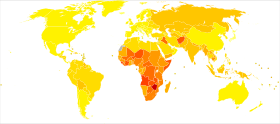
No data
Fewer than 9,250
9,250–16,000
16,000–22,750
22,750–29,500
29,500–36,250
36,250–43,000
43,000–49,750
49,750–56,500
56,500–63,250
63,250–70,000
70,000–80,000
More than 80,000
Disability-adjusted life years (DALYs) are a measure of overall disease burden, expressed as the number of years lost due to ill-health, disability, or early death. It was developed in the 1990s as a way of comparing the overall health and life expectancy of different countries.
DALYs have become more common in the field of public health and health impact assessment (HIA). They include not only the potential years of life lost due to premature death but also equivalent years of 'healthy' life lost by virtue of being in states of poor health or disability. In so doing, mortality and morbidity are combined into a single, common metric.[2]
- ^ "Disease and injury country estimates". World Health Organization. Archived from the original on 2009-11-11. Retrieved Nov 11, 2009.
- ^ "Metrics: Disability-Adjusted Life Year (DALY)". WHO. Archived from the original on Feb 20, 2020. Retrieved 2020-01-02.